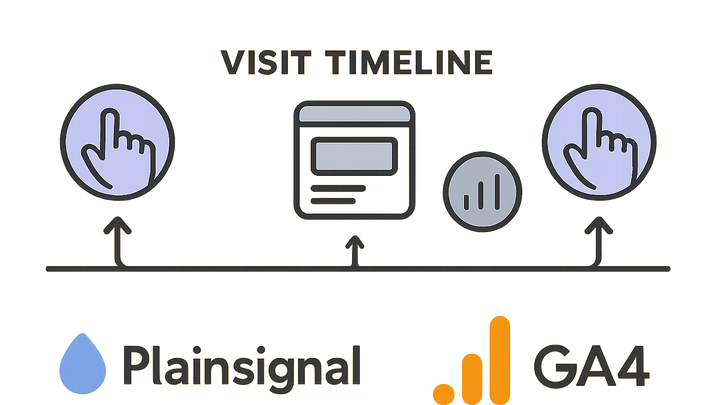Published on 2025-06-28T08:17:19Z
What is a Visit? Examples in PlainSignal and GA4
In web analytics, a Visit (often called a session) represents a series of user interactions with a website within a defined time frame (commonly 30 minutes of inactivity). Each visit can encompass multiple pageviews, events, and other actions. Different analytics platforms may vary in their logic: cookie-based tools like Google Analytics 4 (GA4) use cookies and session_start events, whereas cookie-free solutions like PlainSignal rely on adaptive fingerprinting and timing windows. Understanding visits is crucial for measuring engagement and the effectiveness of marketing campaigns. This entry explores how visits are defined and tracked in both cookie-free and traditional analytics.
Visit
A Visit groups user interactions into a session, tracked differently by cookie-free PlainSignal and cookie-based GA4.
Understanding Visits
Visits represent a fundamental unit in web analytics, encapsulating all user interactions on a website within a specific timeframe. This section covers what constitutes a visit and why it serves as a cornerstone metric for user engagement and retention analysis.
-
Visit defined
A visit is a series of user interactions—such as pageviews, clicks, and events—on a website within a configured time window (commonly 30 minutes of inactivity). Each visit starts when a user first lands on a page and ends after the specified period of no activity.
-
Visit vs pageview
A pageview records each individual page load or reload, whereas a visit can include multiple pageviews and actions, providing a broader view of user behavior during a single timeframe.
Visits in Cookie-free Analytics (PlainSignal)
PlainSignal offers cookie-free visit tracking, relying on browser and network signals instead of client-side cookies. This approach enhances user privacy while still providing actionable visit data.
-
Cookie-free tracking
PlainSignal uses a combination of browser fingerprints and timing heuristics to identify visits without storing cookies on the user’s device. This ensures compliance with privacy regulations and avoids consent pop-ups.
-
Default visit timeout
By default, PlainSignal ends a visit after 30 minutes of inactivity, aligning with standard analytics conventions but without relying on cookies.
Visits in Google Analytics 4 (GA4)
GA4 tracks visits through session_start events and cookies, offering detailed insights into traffic sources, user properties, and campaign attribution. Sessions are the primary grouping of user interactions in GA4.
-
Session_start event
In GA4, a session_start event is automatically logged when a user first loads a page or re-enters after a session timeout, marking the beginning of a visit.
-
Session timeout & attribution
GA4 uses a default 30-minute inactivity window to close a session. It attributes sessions to the original campaign source until a new campaign tag is detected or the session resets.
Implementing Visit Tracking
This section outlines how to add visit tracking to your website using PlainSignal and GA4, complete with HTML snippets you can integrate directly.
-
PlainSignal tracking snippet
Insert the following HTML snippet into your site’s <head> section to enable PlainSignal’s cookie-free visit tracking.
-
Example code
<link rel="preconnect" href="//eu.plainsignal.com/" crossorigin /> <script defer data-do="yourwebsitedomain.com" data-id="0GQV1xmtzQQ" data-api="//eu.plainsignal.com" src="//cdn.plainsignal.com/plainsignal-min.js"></script>
-
-
GA4 tracking snippet
Add the standard gtag.js snippet for GA4 in your <head> to start tracking visits.
-
Example code
<!-- Global site tag (gtag.js) - Google Analytics --> <script async src="https://www.googletagmanager.com/gtag/js?id=GA_MEASUREMENT_ID"></script> <script> window.dataLayer = window.dataLayer || []; function gtag(){dataLayer.push(arguments);} gtag('js', new Date()); gtag('config', 'GA_MEASUREMENT_ID'); </script>
-
Best Practices and Considerations
Adopting robust tracking strategies ensures accurate visit data while maintaining user trust and compliance.
-
Privacy compliance
Use cookie-free tracking or obtain explicit user consent to comply with regulations like GDPR and CCPA.
-
Adjusting session timeouts
Customize session timeout durations based on typical user behavior to avoid fragmented or inflated visit counts.
-
Cross-device and cross-browser limitations
Visits are scoped to individual browsers or devices; merging across contexts often requires user authentication or advanced stitching methods.
